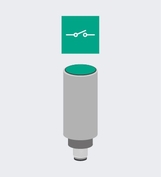Available Types of Output

Each sensor output type provides information as to whether it is a binary (switching) sensor with two defined states, analog output values, or a data-transferring (measuring) sensor. Below you will learn about the types of output for which capacitive sensors are available and how these outputs work.
Switching Sensors
Note: You can find information on the electrical connection of different sensors according to their types of output under Sensor Connection.
This range includes traditional capacitive sensors, i.e., simple on/off switches. They can switch between two defined states and thus control actuators such as valves, flaps, signal lights, etc.
Capacitive proximity sensors can be connected to digital inputs of programmable logic controllers.
1. Sensor with NPN Output (Signal "Negative")
An NPN output of the sensor connects the output connection to ground when switched. The load is connected between the supply voltage +UB and the sensor's NPN output.

Example of a sensor with NPN output
2. Sensor with PNP Output (Signal "Positive")
A PNP output of the sensor connects the output connection to the supply voltage of the sensor when switched. The load is connected between the PNP output of the sensor and ground L- .
Note: Sensors with PNP output tend to be used more frequently to prevent short circuits to ground.

Example of a sensor with PNP output
3. Sensor with NAMUR Output Signal
A sensor with this type of output generates output signals that correspond to the additional safety function according to the NAMUR specifications.

Example of a sensor with a NAMUR output signal
How It Works
NAMUR sensors are two-wire sensors that represent the switch state via specific current values as defined in the EN 60947-5-6 standard. NAMUR sensors are usually connected to isolated switch amplifiers that interpret the current values of the NAMUR sensor and convert them into discrete switching outputs. Together with a suitable isolated switch amplifier, NAMUR sensors form an intrinsically safe circuit for use in explosion-hazardous areas. Alongside the switching output control, the isolated switch amplifier provides short-circuit and lead breakage detection.
Two versions:
Traditionally, NAMUR sensors have a constant output characteristic. NAMUR sensors with this output characteristic are marked with "N" in the type designation.

Area 0: unactuated area
Red area between 0/I: impermissible area of the switch amplifier
Area I: actuated range
Area ≤ 0.15 mA: lead breakage
Area ≥ 6.5 mA: short circuit
In addition, Pepperl+Fuchs offers NAMUR sensors with binary switching characteristics. NAMUR sensors with this output characteristic are marked with "N0" (normally-closed characteristics) or "N1" (normally-open characteristics) in the type designation.

Area 0: unactuated area
Red area between 0/I: impermissible area of the switch amplifier
Area I: actuated range
Area ≤ 0.15 mA: lead breakage
Area ≥ 6.5 mA: short circuit
4. Sensor with Digital Current Output
A sensor with digital current output is a conventional, binary capacitive sensor. The switching signal is issued in the form of two discrete current values.

Example of a sensor with digital current output
How It Works
Binary capacitive sensors are usually used for presence detection. The object detection state is transmitted as a binary signal (switching signal).
Output current 5mA: no object detected
Output current 10mA: object detected
Output Logic

A typical output function of capacitive sensors is binary "switching." Based on two different states, different functions are possible. The repeat accuracy and switching hysteresis must be observed.










 +65 6779 9091
+65 6779 9091